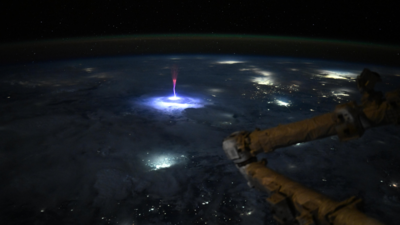Astronaut Captures Elusive Red Sprite from Space, Aiding Atmospheric Research
While orbiting above North America, NASA astronaut Nichole Ayers photographed a rare and stunning atmospheric phenomenon: a red sprite. This Transient Luminous Event (TLE) appeared as a fleeting burst of red light high above thunderstorms over Mexico and the United States.
 *Captured from space: A red sprite, a rare atmospheric phenomenon.*
*Captured from space: A red sprite, a rare atmospheric phenomenon.*
Sprites, a type of TLE, are brief flashes of red light that occur high above powerful thunderstorms. These massive bursts of electrical energy can reach altitudes of up to 100 kilometers above the Earth's surface. Unlike typical lightning, they consist of "cold plasma," similar to the glow inside a fluorescent light tube.
The high altitude and short duration of sprites make them rarely visible from the ground. This makes Ayers' space-based capture particularly significant.
Sharing the image on social media, Ayers exclaimed, "Just. Wow. As we went over Mexico and the U.S. this morning, I caught this sprite."
She further explained, "Sprites are TLEs or Transient Luminous Events that happen above the clouds and are triggered by intense electrical activity in the thunderstorms below."
Sprites have captivated scientists and pilots for decades. These jellyfish-shaped flashes shoot upward into the atmosphere and vanish in milliseconds. Though pilots had reported seeing them for nearly a century, many scientists dismissed them as myths or optical illusions until 1989, when the first clear image of a sprite was accidentally captured on camera.
NASA explains that sprites occur when strong lightning discharges interact with Earth’s ionosphere. The reddish glow is produced when the discharge travels upward and collides with nitrogen molecules. Sprites are part of a larger group of upper-atmosphere phenomena, including blue jets and red elves.
The image sparked amazement and curiosity online. One user commented, "Sprite.... one of the rarest of rare celestial phenomenon.”
Another asked, “How long do the sprites last? Is this a still shot taken from a video? What altitude did this one reach? The more we find out, it becomes obvious we know far less than we thought.”
Older articles
 Evil Eye Amulet: Protective Charm or Portal to Dark Forces? A Cultural Debate
Evil Eye Amulet: Protective Charm or Portal to Dark Forces? A Cultural Debate
 Paralympic Archer Sheetal Devi's Viral Video Shows Her Driving Car with Feet, Defying Expectations
Paralympic Archer Sheetal Devi's Viral Video Shows Her Driving Car with Feet, Defying Expectations
 Umpire Controversy Erupts: West Indies Coach Sammy Questions Holdstock's Consistency in Barbados Test
Umpire Controversy Erupts: West Indies Coach Sammy Questions Holdstock's Consistency in Barbados Test
 Jayden Seales Fined by ICC for Provocative Gesture During Australia Test Match
Jayden Seales Fined by ICC for Provocative Gesture During Australia Test Match
 Prithvi Shaw Hears Tendulkar's Call to Reclaim His Cricket Career After Setbacks
Prithvi Shaw Hears Tendulkar's Call to Reclaim His Cricket Career After Setbacks
 Birmingham Practice Raises Questions: Bumrah's Fitness in Doubt, Arshdeep & Akash Deep Vie for Spot, Focus on Tail-End Batting
Birmingham Practice Raises Questions: Bumrah's Fitness in Doubt, Arshdeep & Akash Deep Vie for Spot, Focus on Tail-End Batting
 Doctor Who Oversaw Rishabh Pant's Recovery Reacts to His Somersault Celebration After Century vs. England
Doctor Who Oversaw Rishabh Pant's Recovery Reacts to His Somersault Celebration After Century vs. England
 5 Silent Signals: How to Spot Prediabetes Without a Blood Test
5 Silent Signals: How to Spot Prediabetes Without a Blood Test
 Moto G54 Price Slashed in India: Check Out the New, Lowered Cost of Motorola's Budget Phone
Moto G54 Price Slashed in India: Check Out the New, Lowered Cost of Motorola's Budget Phone
 Headline:
7 Interview Habits That Will Help You Land the Job (Without Sounding Rehearsed)
Headline:
7 Interview Habits That Will Help You Land the Job (Without Sounding Rehearsed)